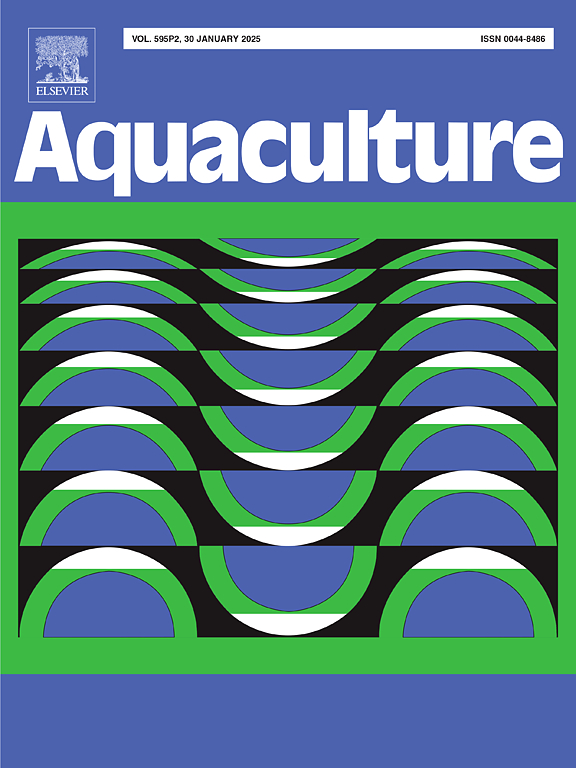Taurine related pathways effect the potential domestication of wild Larimichthys crocea adapt to stress environment
IF 3.9
1区 农林科学
Q1 FISHERIES
引用次数: 0
Abstract
The large yellow croaker (Larimichthys crocea) was inherently sensitive and exhibited pronounced responses to external stimuli, which posed challenges for its domestication and breeding. The swim bladder, a sensory organ richly innervated with sympathetic and parasympathetic nerves, played a critical role in this process. However, the molecular mechanisms underlying the neural and physiological changes induced by domestication remained unclear. In this study, significant differences in metabolic profile and gene expression were identified in swim bladder when compared cultured and wild L. crocea, as well as in metabolic profile of liver. Taurine and hypotaurine metabolism were notably enriched in the swim bladder and liver. Taurine levels were significantly higher in the swim bladder of wild individuals, and after injection of taurine, gene expression levels of taurine synthesis in swim bladder were elevated, while taurine transport and metabolism genes in swim bladder and liver were also upregulated. In addition, taurine alterations were associated with differential expression of neuroregulatory genes. Swim bladder inflation and deflation resulted in varying degrees of reduction or deformation of the Nissl bodies and elevated expression of neural regulatory genes after pressure and noise exposure. Pressure and noise processing affected neural regulatory genes such as angpt2, lepr, foxm1 and sema3d. These genes showed minimal changes in expression during stress and noise processing, with noise having a greater impact on neural regulation in the brain. Taurine injection significantly increased expression of angpt2, lepr, foxm1 and sema3d under pressure stress but decreased them under noise stress. Conversely, notch1a, tmc1, colla1a, and mylpfa were consistently downregulated in the swim bladder and brain under both stress conditions. This study was the first to propose a swim bladder-brain axis regulating neural sensitivity in L. crocea, providing new insights into the molecular mechanisms through which domestication and aquaculture affected the neural responses of this species.

大黄鱼(Larimichthys crocea)天生敏感,对外界刺激有明显的反应,这给其驯化和繁殖带来了挑战。鳔是一个由交感神经和副交感神经支配的感觉器官,在这一过程中起着至关重要的作用。然而,驯化引起的神经和生理变化的分子机制仍不清楚。本研究发现,与野生黄花鱼相比,养殖黄花鱼的鳔和肝脏的代谢特征和基因表达存在显著差异。牛磺酸和低牛磺酸代谢在鳔和肝脏中明显富集。野生个体鳔中的牛磺酸水平明显较高,注射牛磺酸后,鳔中合成牛磺酸的基因表达水平升高,鳔和肝脏中牛磺酸转运和代谢基因也上调。此外,牛磺酸的改变还与神经调节基因的不同表达有关。鳔的充气和放气导致尼氏体不同程度的缩小或变形,神经调控基因的表达在受到压力和噪音影响后升高。压力和噪音处理影响了神经调控基因,如 angpt2、lepr、foxm1 和 sema3d。这些基因在压力和噪音处理过程中的表达变化极小,而噪音对大脑神经调控的影响更大。牛磺酸注射能明显增加压力应激下 angpt2、lepr、foxm1 和 sema3d 的表达,但降低噪音应激下它们的表达。相反,在两种压力条件下,notch1a、tmc1、colla1a和mylpfa在鳔和大脑中的表达均持续下调。该研究首次提出了调节大黄鱼神经敏感性的鳔-脑轴,为驯化和养殖影响该物种神经反应的分子机制提供了新的见解。
本文章由计算机程序翻译,如有差异,请以英文原文为准。
求助全文
约1分钟内获得全文
求助全文
来源期刊

Aquaculture
农林科学-海洋与淡水生物学
CiteScore
8.60
自引率
17.80%
发文量
1246
审稿时长
56 days
期刊介绍:
Aquaculture is an international journal for the exploration, improvement and management of all freshwater and marine food resources. It publishes novel and innovative research of world-wide interest on farming of aquatic organisms, which includes finfish, mollusks, crustaceans and aquatic plants for human consumption. Research on ornamentals is not a focus of the Journal. Aquaculture only publishes papers with a clear relevance to improving aquaculture practices or a potential application.
 求助内容:
求助内容: 应助结果提醒方式:
应助结果提醒方式:


